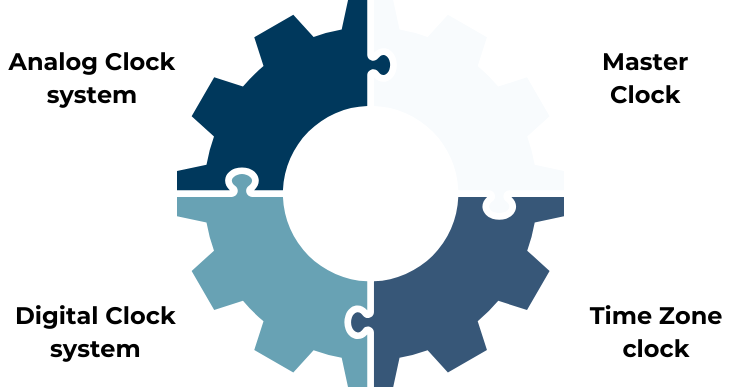Master Clock
A Master Clock is a centralized timing device used to synchronize and coordinate timekeeping within a specific network or facility. It serves as a reference point for all clocks and timing devices connected to it, ensuring consistent and accurate time across an organization. Here’s an overview of the components, functions, and applications of a Master Clock system.
- Components of a Master Clock System:
- Master Clock Unit: The central device that generates and distributes precise time signals to all synchronized clocks within its network.
- Secondary Clocks: Analog or digital clocks that receive time signals from the master clock and display synchronized time.
- Time Code Distribution: Methods such as wired connections (e.g., Ethernet, RS-485) or wireless technologies (e.g., Wi-Fi, radio signals) used to distribute time information to secondary clocks and systems.
- Redundancy and Backup Systems: Some master clock systems include redundant components or backup power sources to ensure continuous operation and reliability.
- Functions of a Master Clock:
- Time Synchronization: Provides a single, accurate time reference for all clocks and timekeeping devices within a facility or organization.
- Time Distribution: Distributes synchronized time signals to secondary clocks, ensuring consistent time displays throughout a building, campus, or enterprise.
- Control and Management: Allows administrators to set, adjust, and manage time settings centrally, reducing the need for manual adjustments and ensuring compliance with scheduling and operational requirements.
- Integration with Systems: Often integrated with other systems such as security access control, public address systems, and networked devices that require precise time synchronization.
- Applications of Master Clock Systems:
- Corporate Environments: Used in office buildings, financial institutions, and corporate campuses to maintain synchronized time across departments and operations.
- Educational Institutions: Ensures consistent timing for class schedules, exams, and events across school campuses.
- Transportation and Logistics: Coordinates timing for schedules, timetables, and operational activities in airports, railway stations, and logistics hubs.
- Healthcare Facilities: Critical for synchronized operations, patient care schedules, and medical procedures in hospitals and clinics.
- Industrial and Manufacturing: Supports timing for production schedules, shift changes, and automated processes in factories and manufacturing facilities.
- Advanced Features and Considerations:
- Precision and Accuracy: Master clocks are designed to maintain high levels of accuracy, often using atomic clocks or GPS receivers to synchronize time to global standards.
- Scalability: Systems can scale from small installations with a few clocks to large networks spanning multiple buildings or locations.
- Security and Reliability: Robust security protocols and redundant systems ensure continuous operation and protection against disruptions or unauthorized access.
In summary, a Master Clock system is essential for maintaining synchronized time across diverse applications and environments, ensuring operational efficiency, compliance with schedules, and coordination of activities within organizations. Its role extends beyond mere timekeeping, contributing to overall productivity, coordination, and reliability in various sectors.
